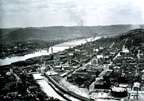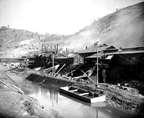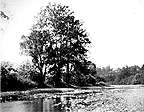
Wheeling
Creek Case Study: Environmental History
Wheeling
was first settled in 1769 near the site of Fort Henry. National Road,
U.S. Route 40, was completed to Wheeling in 1818. It was the first
road link from the east coast to the Ohio River. This opened Wheeling
as a gateway to western expansion.
 Downtown
Wheeling in 1890 shows a highly industrialized urban center, including
river and rail transportation facilities, as well as bridges carrying
roads across the Ohio River. River travel was essential to the expansion
of Wheeling's industrial base. Photo:
Courtesy of the Oglebay Institute, Wheeling, WV. Downtown
Wheeling in 1890 shows a highly industrialized urban center, including
river and rail transportation facilities, as well as bridges carrying
roads across the Ohio River. River travel was essential to the expansion
of Wheeling's industrial base. Photo:
Courtesy of the Oglebay Institute, Wheeling, WV. |
 Wheeling
from Chapline Hill in 1890 shows lower Wheeling Creek from about
2 km (1.2 mi.) upstream. Notice that lower Wheeling Creek had been
dredged to provide barge access to new industrial sites. Photo:
Courtesy of the Oglebay Institute, Wheeling, WV. Wheeling
from Chapline Hill in 1890 shows lower Wheeling Creek from about
2 km (1.2 mi.) upstream. Notice that lower Wheeling Creek had been
dredged to provide barge access to new industrial sites. Photo:
Courtesy of the Oglebay Institute, Wheeling, WV. |
 McCullock's
Leap Area in 1892 shows the area about 3 km (1.9 mi.) upstream
from the Ohio River. What features can you identify from these photographs
that may have impacted the biological communities of Wheeling Creek?
Photo: Courtesy of the Oglebay Institute,
Wheeling, WV. McCullock's
Leap Area in 1892 shows the area about 3 km (1.9 mi.) upstream
from the Ohio River. What features can you identify from these photographs
that may have impacted the biological communities of Wheeling Creek?
Photo: Courtesy of the Oglebay Institute,
Wheeling, WV. |
 Site
of Wheeling Creek Wall in 1890 provides a closer examination of
the stream. Note the structure of the stream banks, stream bed, plants
growing in the stream bed, streamside vegetation, and the vegetation
on the hillsides along lower Wheeling Creek. Photo:
Courtesy of the Oglebay Institute, Wheeling, WV. Site
of Wheeling Creek Wall in 1890 provides a closer examination of
the stream. Note the structure of the stream banks, stream bed, plants
growing in the stream bed, streamside vegetation, and the vegetation
on the hillsides along lower Wheeling Creek. Photo:
Courtesy of the Oglebay Institute, Wheeling, WV. |
 Site
of Wheeling Creek Wall in 1996 From the same view as above, can
you tell what this stream looked like in 1890? Photo:
Courtesy of Dr. Ben Stout. Site
of Wheeling Creek Wall in 1996 From the same view as above, can
you tell what this stream looked like in 1890? Photo:
Courtesy of Dr. Ben Stout. |
 Scene
on Big Wheeling Creek in 1904 Compare these features to those in
the photos approximately 12 km (7.5 mi.) downstream. What are the
similarities and differences between these areas of the Wheeling Creek
watershed? Did U.S Route 40 and the Baltimore and Ohio Railroad travel
along this site on Big Wheeling Creek? Photo:
Courtesy of the Oglebay Institute, Wheeling, WV. Scene
on Big Wheeling Creek in 1904 Compare these features to those in
the photos approximately 12 km (7.5 mi.) downstream. What are the
similarities and differences between these areas of the Wheeling Creek
watershed? Did U.S Route 40 and the Baltimore and Ohio Railroad travel
along this site on Big Wheeling Creek? Photo:
Courtesy of the Oglebay Institute, Wheeling, WV. |
Overview
..|.. Environmental
History ..|..
Name
That Pollutant
Glossary .|.
Related Links
.|..
References
..|..
PBL Model
.|
Home ..|.. Teacher Pages ..|.. Modules & Activities
HTML code by Chris Kreger
Maintained by ETE Team
Last updated November 10, 2004
Some images © 2004 www.clipart.com
Privacy Statement and Copyright © 1997-2004 by Wheeling Jesuit University/NASA-supported Classroom of the Future. All rights reserved.
Center for Educational Technologies, Circuit Board/Apple graphic logo, and COTF Classroom of the Future logo are registered trademarks of Wheeling Jesuit University.